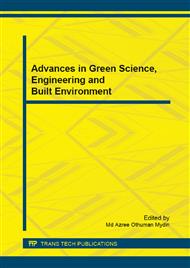p.234
p.238
p.242
p.246
p.250
p.257
p.261
p.265
p.269
Prefab Materials for Self Build Housing System in Malaysia
Abstract:
Prefabricated system has been used extensively in many developed and developing countries to provide low cost housing. There are many case studies that took the advantage of prefabricated system as part of self help approach in house construction. Prefabricated system in self help housing proved to be cost effective, provide employment opportunities, utilise low skill levels and maximise local natural resources. Malaysia is also promoting prefabricated system to be used in low cost housing provision. There are obstacles to implement such technology into the conventional construction industry. This paper investigates the possibility of adapting local resources, such as timber, into prefabricated components as a mean to promote not only modular coordination concept but also promote self build approach in the community at a lower skill labour. It is not an immediate solution to housing issues yet it provides alternatives to house the low income group and contribute to increase the supply of housing.
Info:
Periodical:
Pages:
250-253
Citation:
Online since:
March 2015
Price:
Сopyright:
© 2015 Trans Tech Publications Ltd. All Rights Reserved
Share:
Citation:


